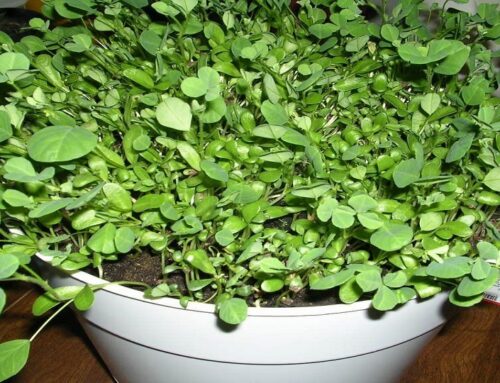Mustard spinach is a highly nutritious brassica vegetable or cruciferous vegetable belonging to the family Brassicaceae. It is a green leafy vegetable just like spinach and mustard leaves but it is neither mustard nor spinach. However it belongs to mustard family, i.e. Brassicaceae. In other words, it is a leafy Brassica vegetable grown for its highly nutritious edible leaves.
Scientific name of mustard spinach is Brassica perviridis or Brassica rapa perviridis. Its common names are, Komatsuna, Japanese mustard spinach, tender green mustard, and spinach mustard.
Food Uses: Mustard spinach is cooked just like spinach. It is used as salad greens and cooked as a delicious leafy vegetable. It may be boiled to soups or cooked as a stir-fried vegetable.
Nutrition in Mustard Spinach: Like other leafy greens, mustard spinach is also an excellent source of powerful antioxidants, minerals and vitamins. According to USDA, 100grams of edible portion of raw mustard spinach provides 22 kilo calories of energy and contains 92.2g water, 2.2g protein, 0.3g fat, 3.9g carbohydrates, and 2.8g fiber. In addition to this, it has 0.138g MUFA, 0.057g PUFA and 0.015g saturated fatty acids.
According to USDA, 100grams of edible portion of COOKED mustard spinach provides 16 kilo calories of energy and contains 94.5g water, 1.7g protein, 0.2g fat, 2.8g carbohydrates, and 2g fiber.
Growing Practices for Mustard Spinach: Mustard spinach thrives well in cool climate even though it can be grown in warmer climates also. Propagation of mustard spinach is by seeds. Seeds may be sown almost a month before last frost. It may take 5-10 days for seedlings to emerge. Direct seeding in groups of 3 seeds is practiced if it is grown in open fields. For container growing of mustard spinach, seedlings are raised indoors.
Site is prepared by ploughing and leveling the land. Raised beds or ridges are prepared and later pits are made on these ridges to sow the seeds. Seeds are sown at a depth of 0.5 to 1 cm. Seeds are sown in pits which are spaced at 15-20 cm apart within a row. Row to row distance within a ridge is about 2.5 -5 cm. When plants are 10-15 cm tall, thinning is done keeping one plant for every 15-20 cm distance within a row.
Moist soil is preferred for mustard spinach growth. Soon after sowing seeds and thinning a light irrigation is given. On average mustard spinach plants need to be watered at weekly intervals. While watering the plants, make sure that top 15-20 cm of soil is watered properly. After every harvest, watering is recommended to boost leaf production.
Since leaf production has to be promoted, application of liberal doses of nitrogen fertilizers are recommended. Farm yard manure or compost @40-50tons/ha may be incorporated into the top soil at the time of field preparation. After that a top dressing of 20 kilograms of nitrogen per hectare may be given after every harvest. For container growing, foliar application of a liquid nitrogen fertilizer is a good idea after every harvesting of leaves.
Growth duration of mustard spinach is approximately one or two months. Harvesting is done when plants are about 20-30 cm tall. Harvesting is done with a sharp knife or blade from the outside of the plants while interior leaves are left undisturbed to continue growth. Harvesting may be done at weekly or biweekly intervals as and when new growth appears. Continuous harvesting is possible only when harvesting is done from outside towards interior of the plant while leaving new growth undisturbed. For salad uses, tender plants may carefully be pulled from the base and roots are trimmed.
We have a book on ‘Spinach Herbs‘….
Check out our publishing services here…
We publish top quality videos on various ‘Food & Agriculture’ topics. You may subscribe our video channel here…






